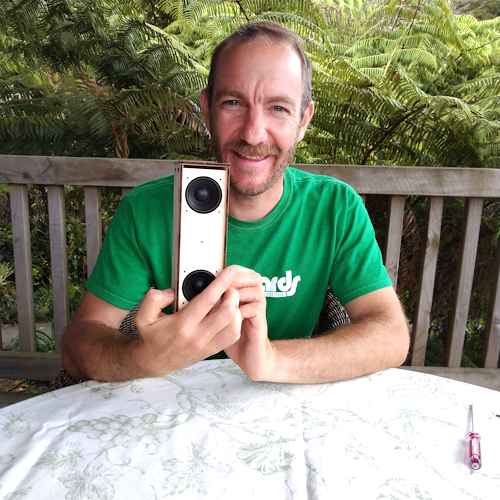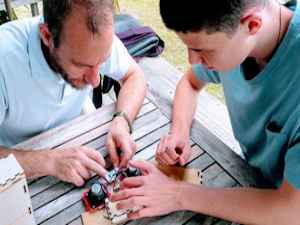"You Can't Just Chuck a Speaker in a Box"
Make Your Own Bluetooth Speakers
By Stefan Sharpe
So you want to make a Bluetooth speaker? Here’s a few things you need think about first.
SOUND IS TRICKY
If you’ve ever watched a speaker playing music, you will notice that the Electro-mechanical Driver, (the black cone-shaped bits we’re used to seeing), move. They are moving to produce sound waves.
Sound waves are pressure waves traveling through the air - and air is squishy stuff. These waves squash or stretch the air, and eventually they hit the small bones in our ears, vibrating them and causing us to “hear”.
So let's say you buy some Speaker (electro-mechanical) Drivers, and the other bits you need to make them go. What happens if you just hook the wires up to them, and try to play some music?
YOU'LL GET MUDDY SCREECHING!
You will have a rather horrid sound experience because at the same time the Speaker Drivers produce sound waves at the front, they produce them at the back as well. These will mix, attempting to cancel each other out.
Sometimes you’re at the beach and you see a huge wave crashing into another wave coming from the other direction. You end up with a kind of wobbly flat bit. This is similar. If the sound waves could cancel one another exactly, then you would get silence - noise cancelling.
If you’re Adam Savage (Mythbusters) and have an entire team of scientists at your disposal, you might be successful – see here at his “Adam Savage 'Unrings a Bell - Unimpossible Missions”'. But even they struggled with the big issue, namely, that sound comes out omni-directional and bounces off everything, then bounces to your ears - and you get bad noise. Like, real bad.
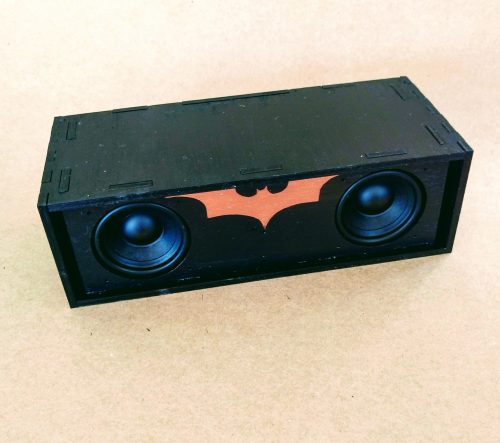
SPEAKER DRIVERS AREN’T EASY EITHER
If you didn’t know the above, you might think that the Speaker Drivers you bought are terrible. Sadly, this may also be true - most are not very good.
It is quite easy to make Speaker Drivers that make high sounds, (sound of a mosquito anyone?), but hard to make ones that do deep thunder. You need to find some that do a big range - from low rumbles and drums, to high tinkles.
ENTER PASSIVE RESONATORS
Often cheap bluetooth speakers use cheap Speaker Drivers but, mysteriously, they advertise lots of deep bass. What’s going on?
Manufacturers resort to using a nifty device called a Passive Resonator to make up for the cheap componentry. This has the effect of producing very deep bass – but at the expense of mid-range and higher sound. So you’ll get your deep drums but the singing and mellow guitars may sound rubbish.
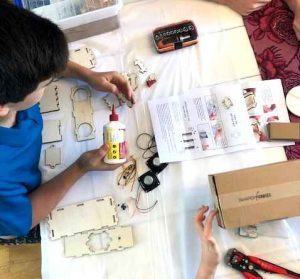
Once you understand some of the electronics, you need to think about actually making a speaker.
FIRST: MAKE A COMPACT SPEAKER
Yes, that’s what everyone wants. A portable, smart-looking, compact speaker that pumps out the bass right?
But consider the box. The smaller your box, the harder it is to get quality sound because of the pesky physics of sound waves we just discussed.
For this reason, most quality speakers are in a large box. The speakers are usually at the front and there is a large box of air at the back. The size of the box is important because the speakers need to move to generate the pressure waves. Once the speaker is in a box, it has to compress and push against the air inside - and this gets harder as the box gets smaller. Remember what happens when you have a Speaker Driver running by itself? The big box simply muffles the sound off the back of the speaker.
But, surely that’s a waste? And after all, there are a lot of compact speakers out there.
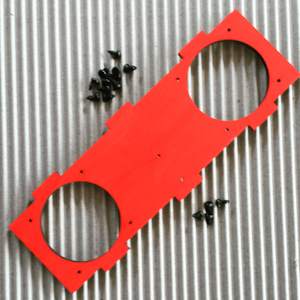
JUST STICK A HOLE IN IT?
Ah ha! If you are brave or technical, you can harness the power of the back of the speaker and “tune”, (ie: hopefully make smaller), the size of your box if you put a hole of just the right size and shape in it.
What could be easier - right? Hmmmm.
There are lots of different ideas out there about how to tune a speaker box to produce better sound. You will find many, many formulas and opinions on the correct way to do this, but there is no substitute for just trying lots of different shapes and sizes until it sounds good. You may want to allow a bit of time for this process. (Like, a few weeks).
The hole/box ratio is important because this is used mostly to increase the deep bass sound of the speaker. Most small Speaker Drivers are much less effective at producing deep bass sounds so the location of the hole, and size of the box need to work together perfectly.
NEXT: FIND YOUR QUALITY SPEAKER DRIVER
Once you’ve decided on the box size, you need to find a quality Speaker Driver because these are not all made equal. As mentioned, most small Speaker Drivers have poor performance – especially when it comes to bass sound.
THEN: YOUR QUALITY (LOW VOLT) AMPLIFIER
Next, you need an appropriate amplifier.
These take a tiny electrical signal from your digital device and massively amplify it to power the Speaker Driver. And again, not all amplifiers are created equal so you do need to do your research.
Until recently, amplifiers tended to be quite inefficient – they gave out a lot of heat and not much noise. However, new digital amplifiers have been developed that are much more efficient. The snag is these usually require a high voltage to operate.
DON'T FORGET YOUR (LOW VOLT) BLUETOOTH MODULE
So now you have your amplifier, you’ll need a Bluetooth Module which acts like a tiny radio receiver. It receives radio signals from your smart device and converts them into an audio signal which it sends to the amplifier.
The tricky thing is to find an amplifier and Bluetooth module that operate at low voltage. Commonly these run at 12 volts – the equivalent of 8 AA batteries.
Lastly, you will also need a battery box, switch, wires and various other electronic things that we assume you already know about. Hurray - that's everything!
Or, you can just buy our DIY Bluetooth Speaker kit feeling confident that we've thought through all of the above for you, which means you can just do the fun bit - make it, enjoy it.
Cheers, Stephan
